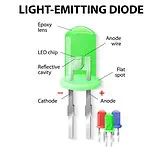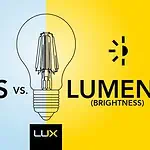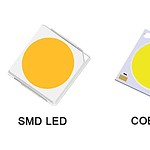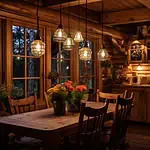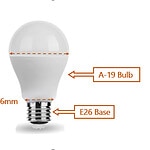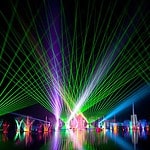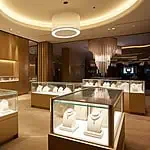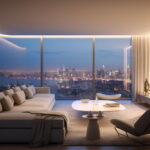LED tube lights seem very basic, but the variations in ballast type and light sizes will amaze you! There is much more to know about installing LED tube lights, as ballast compatibility is a major concern here.
LED tube lights are highly energy efficient and durable compared to the fluorescent ones. They are available in different variants, including- type A, type B, type C, and hybrid tubes. Some of these require ballast, while others don’t. Besides, depending on tube size, you can choose between T8, T12, and T5. The T8 tube and B-type lights don’t require any ballast, whereas you need to use ballast for type A LED tube lights. However, the hybrid tube lights can work with or without ballast. So, when installing the fixture, you must consider these facts. Apart from this, you should also check the wattage, CCT, CRI, energy efficiency, dimmable or not, and other features to choose the ideal one.
Nevertheless, knowing the pros and cons of LED tube light is also essential. Therefore, I have also mentioned all the facts you should explore, including the differences between LED and fluorescent tube lights. So, without wasting much more time, let’s start–
What Is LED Tube Light?
An LED tube is an LED linear lamp designed to function similarly to a fluorescent fixture. It is beneficial, affordable, and effective. Also, this light enhances color rendering and saves more money and energy (30% more efficient than regular fluorescent tubes). It is reliable, needs less maintenance, and burns out less. You can easily switch the LED tube with your old fluorescent tube as it fits the same fixtures.
In addition, the LED tube comes in different colors, doesn’t flicker like fluorescent light, and you can get dimmable ones without spending too much. It is also better for the environment because LED tubes don’t have any mercury.
Types Of LED Tube Light
The types of LED tube lights vary based on wiring and ballast compatibility and size. Here, I will describe both of them in detail–
Based On Wiring & Ballast Compatible
Let’s see the types included in the wiring and ballast-compatible system–
Type A: Electronic Ballast Compatible Tubes
This LED tube light is built with an internal driver to operate directly from the linear fluorescent ballast, also known as plug-and-play. The wattage and lumen output for this kind of tube can be managed by current ballasts such as low electricity (LP), regular strength (NP), and excessive electricity (HP). Almost all these lights are made to work with T5, T8, and T12 ballasts. However, it is best to check the ballast compatibility before using Type A LED tubes. Besides, type A LED tube lights are easy to install. To switch from the current fluorescent tube to a UL Type A LED tube, you just need to replace it. Unlike other options, there’s no need to change the wiring or structure of the existing light fixture.
Note: UL refers to Underwriters Laboratories (UL). It is a certification or standard for light bulbs, lamps, or outlets purchased in the U.S. The fixtures with this certification are considered safe and are marked as UL-listed.
Type B: Direct Wire Tubes
Direct wire, ballast bypass, or type B are the most widely used tube lights. They are fluorescent ballast bypass LED linear lamps. More specifically, the internal driver of Type B is powered straight from the primary supply voltage to the linear fluorescent lamp or LFL fixtures. And this is why they are known as line voltage lamps. However, it requires significant considerations, such as GE’s Type B needs an in-line fuse.
Type C: External Driver LED Tubes
Type C LED tubes are externally powered linear lamps. This light requires a driver mounted on the fixture and is installed similarly to conventional fluorescent ballasts and lamps. The advantages of Type C LEDs are the dimming feature and extended lifespan. Besides, installing a UL Type C tube requires the removal of existing tubes and ballasts, with potential socket replacement if damaged. Also, the fixture’s input wires have to be linked to the LED driver. Then, the driver’s low-voltage output wires must be connected to the sockets before installing the new LED linear tubes. Post-installation, the driver can power multiple LED tubes within the fixture.
Type AB: Hybrid Tubes
Hybrid LED tubes or Type AB offer flexibility in usage with or without a ballast. Typically installed in fixtures with a compatible ballast until its lifespan expires, these tubes can be utilized as direct wire bulbs by bypassing the non-functioning ballast. Also, they can function as plug-and-play bulbs with shunted and non-shunted sockets. However, when using shunted tombstones, you need to rewire the fixture with non-shunted tombstones after the ballast failure when using direct wire mode.
Universal Ballast Compatible
These tubes are new and the most expensive variant. They are easy to install and can work with any existing technology, whether T8 or T12. As the installation system is super simple, all you need to do is remove the fluorescent tube and place the LED tube in this position. Moreover, these lights suit homeowners who want to reduce installation downtime. The key disadvantage of these lights is the elevated initial costs per unit. Also, there are maintenance issues as the ballast is in place.
Based On Tube Size
Three types of LED tube lights are available depending on the tube size. For example, T8, T12, and T5 tubes. The “T” stands for “tubular,” which is the shape of the bulb, whereas the number refers to a fraction in eighths of an inch. Let’s see in more detail.
T8 LED Tube
The T8 tube is a famous lighting option for its efficiency with existing fluorescent fixtures. With a diameter of 1 inch (8/8 inches), the T8 tube offers a versatile lighting solution. It is energy-efficient, so you can save substantially over traditional tubes. Also, the T8 tube can provide brighter illumination and has a longer lifespan. Hence, it is suitable for commercial and residential spaces.
T12 LED Tube
The T12 LED tube is another option with a diameter of 1.5 inches (12/8 inches). Although less common today due to its lower energy efficiency, T12 tubes were widely used in the past. They are gradually replaced by more energy-efficient alternatives like T8 and T5 LED tubes. However, T12 LED tubes are suitable for retrofitting older fixtures but can require modifications for best performance.
T5 LED Tube
This is a slim, energy-efficient LED tube type and has a 5/8 inches diameter. T5 LED tube is known for its slim design and energy efficiency. It is a more modern and sustainable alternative to traditional fluorescent tubes with the same diameter (T5 fluorescent tubes). Besides, the T5 tube is suitable for various applications. For instance, you can use them in offices, retail spaces, and residential areas, where a balance between efficient lighting and space optimization is required.
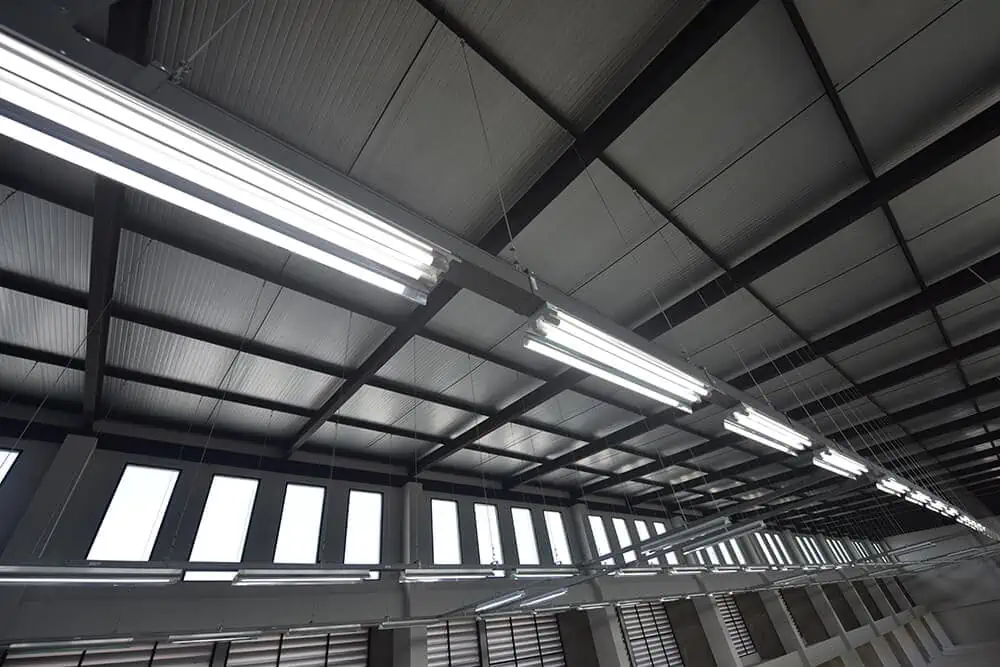
Advantages Of LED Tube Light
Energy efficiency: LED tube lights consume over 90% less energy than incandescent bulbs. As a result, they will lower the electricity costs, which will help you to save money in the long run.
Longer lifespan: Their lifespan is over 60,000 hours than regular incandescent bulbs 1,500 hours. A good LED tube can last up to 7 years of continuous use. They typically last ten times longer than fluorescent lights and 133 times longer than incandescent lights. Therefore, you can reduce operating and maintenance costs with these lights rather than fluorescent and traditional lights.
Durability: LED tubes are built with semiconductor material rather than a gas or neon filament. Also, they consist of a compact chip encased in epoxy. Hence, this can provide greater durability than conventional incandescent bulbs or neon tubes.
Better color rendering: They have a variety of colors like blue, amber, and red. LEDs’ colors can be combined to generate extensive color choices.
Dimmable options: This feature allows you to customize the lighting intensity according to your preferences and needs. Dimmable LED tubes help you to create different atmospheres for any task. Also, it can enhance user comfort by adjusting the brightness to match the requirements.
Instant on: LED tubes instantly illuminate when switched on. This is particularly beneficial in emergencies and security lighting.
Environmentally friendly: Unlike neon lights, LED tubes do not use mercury, which harms the environment. The non-toxic materials are used to make LED tubes. So, they are recyclable and considered environmentally friendly.
Disadvantages Of LED Tube Light
Higher Initial Cost: One key drawback of LED tube lights is their higher initial cost than traditional lighting options. But as LEDs are highly energy efficient and durable, they will save you energy bills and lower the need for frequent light replacement. Thus, using LED tube lights in the long run will be cost-effective despite the high initial cost.
Complex Installation: The installation of LED tube lights can be challenging. For instance, retrofitting existing fixtures or ensuring compatibility with specific ballasts may require technical expertise. So this can lead to installation errors, and you must hire professional assistance for setup and performance.
Limited Compatibility: Often, compatibility issues can arise when integrating LED tubes into older fixtures designed for conventional lighting technologies. Some fixtures can not support LED retrofitting, and you need to necessitate additional modifications or replacements. Directional Light: Unlike traditional incandescent bulbs that emit light in all directions, LED tube lights produce directional light. However, this can be advantageous for focused illumination but can result in uneven light distribution in specific applications. Therefore, using a diffuser or strategic placement, you can mitigate the directional characteristic for more uniform lighting.
Flicker Issues: You can often find LED tubes with flickering issues, leading to discomfort and eye strain for occupants. Flicker problems come with poor-quality LED drivers or incompatible dimming systems. So, selecting high-quality LED products can help mitigate flickering problems.
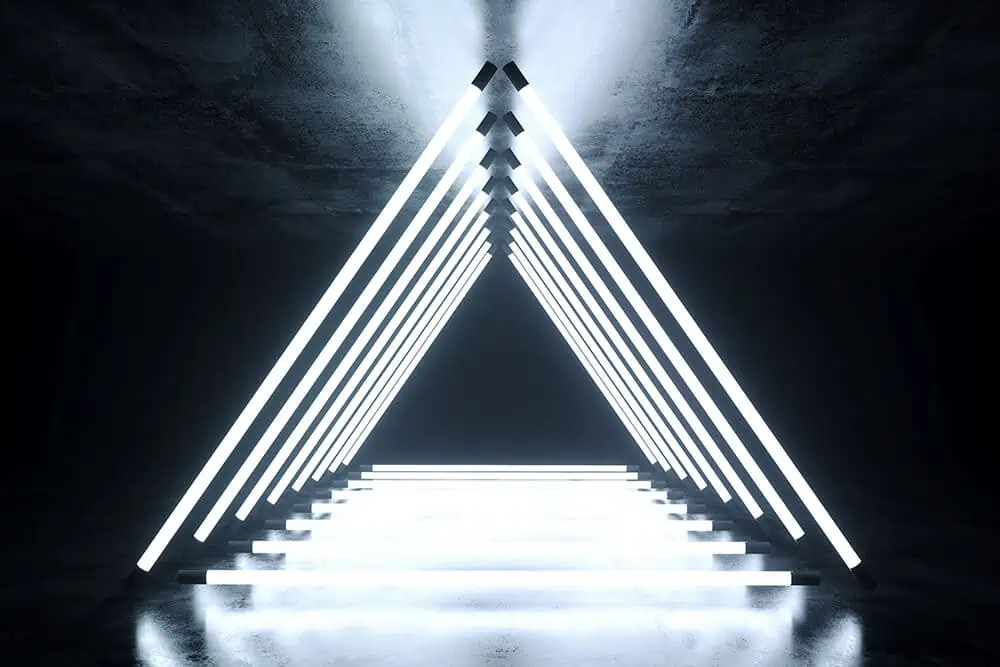
Choosing The Best LED Tube Light – A Guide
The best LED tube lights have some factors for better performance; you need to check them while purchasing one. Below, I have mentioned them; read thoroughly the whole section–
Consider The Location
When selecting the perfect LED tube lights, the first crucial consideration is the installation location. Because indoor and outdoor environments require different functions. For example, you want to install LED tubes for indoor spaces. So, you need to consider brightness and beam angle, which are important in achieving the desired ambiance. At the same time, for outdoor LED tubes, you can check if they are weather-resistant and capable of withstanding varying temperatures and moisture levels. If you have no idea about the best outdoor manufacturer in the world, check this Top 10 Outdoor Lighting Manufacturers In The World (2023). Besides, you need to understand the specific demands of the location to get the best performance in its designated setting. However, read these articles if you are a businessman and want to know more about – Commercial Lighting: A Definitive Guide and A Comprehensive Guide To Industrial Lighting.
Examine The Fixture Type & Ballast Compatibility
The installation system varies based on the type of fixture you choose, such as T8 or T12. So, to identify the current installation, you need to remove the bulb and examine the markings. This gives you essential information about the tube, indicating whether it’s a T8 or T12. However, if you do not find the marking, you can determine the type you have installed by the diameter or the size of the LED tube. For instance, T8 tubes measure one inch, while T12 tubes measure 1 1/2 inches in diameter. On the other hand, tubes with a smaller diameter, around 5/8 inch, are typically T5. After identifying the tube light, you need to consider the ballast compatibility. Usually, T8 tubes utilize electronic ballasts, whereas T12 tubes are associated with magnetic ballasts. Hence, examining the fixture’s ballast provides the final confirmation. Older fixtures are more likely to feature magnetic ballasts. With tube type and ballast considerations clarified, you can confidently select the appropriate product for your needs.
Color Temperature
Color temperature is another option to consider when choosing the best LED tube lights. LED tubes come with several ranges of color temperatures. Typically, color temperatures are measured using the Kelvin Scale (K). And the higher the color temperature, the cooler the lights are. Therefore, there are many ranges available from 2400K to 6500K. You can choose a cool white temperature, 4000K, for office use. On the other hand, if you are searching for lights for the garage, security areas, or parking spot, you can go with 5000K for better visibility. However, if you are also curious about strip light color temperatures, check this–How to Choose LED Strip Color Temperature? In this section below, I have mentioned a chart that describes these multiple color temperature ranges and their uses; take a look–
| Color temperature | Effects | Mood | Uses |
| Warm white (2700K-3000K) | Increase red and orange color, and include yellow tint | Warm, soft, and friendly | Hotels, homes, restaurants, or hospitality |
| Cool white (4000K- 4,500K) | Similar to daylights, a neutral appearance | Clean and efficient | Offices, showrooms |
| Daylights (5000K- 6000K) | Bluish white lightning | Alert and vibrant | Manufacturing, offices, hospital, industries |
Tube Sizes
You also need to think about the tube sizes that you want. For this, you can check the label at the lights’ end. Besides that, you can also measure the diameter to confirm the size. A “T” stands for tubular shape, and the numerical value indicates the bulb diameter in eighths of an inch. For instance, a T8 bulb has a one-inch diameter, a T5 has a 5/8-inch diameter, and a T12 measures 12/8 inches or 1.5 inches in diameter. However, if both T8 and T12 bulbs share the same bi-pin base, they can be used interchangeably in the same fixture.
Brightness & Wattage Selection
The most confusing thing for you while buying an LED tube is determining the correct wattage for the application. This problem arises from the fact that LED lights use only a fraction of the energy compared to traditional technologies like fluorescent lights but produce an equivalent amount of light, measured in lumens. It’s best to focus on understanding the required lumen output for the application to choose the right LED light. It will simplify the selection of an appropriate LED bulb. As the majority of users do not understand the lumen output of their current fluorescent lighting, I have included a chart. Below, you can see a convenient comparison between the lumen output of traditional fluorescent tubes and LEDs. Take a look–
| Fluorescent | LED Wattage | Lumens |
| 40W | 18W | 2,567 lm |
| 35W | 15W | 2,172 lm |
| 32W | 14W | 1,920 lm |
| 28W | 12W | 1,715 lm |
Think About Dimmability
Dimmable LED tubes offer flexibility in adjusting brightness levels to suit various settings and moods. So, you can choose tubes with a wide dimming range for optimal control. Dimmable LEDs will enhance ambiance and allow you to adjust brightness as needed. This feature makes them versatile and cost-effective lighting solutions for different spaces.
CRI
CRI (Color Rendering Index) is critical in choosing the best LED tube light. It measures the light source’s ability to accurately render colors compared to natural light. A higher CRI value indicates better color representation. In environments where color accuracy is paramount, such as retail spaces or art studios, selecting LED tubes with a high CRI ensures vibrant and true-to-life color rendition. So, consider the specific application requirements and choose LED tubes with an appropriate CRI to enhance functionality. To learn more, check this- What is CRI?
Efficiency And Energy Savings
These are critical factors if you want to minimize energy costs. Therefore, for energy efficiency, look for two certificates, DLC (Design Lights Consortium) and ENERGY STAR, in the products. These mean that the lights meet specific energy efficacy standards. Also, they ensure the products are made from quality materials and have undergone much testing. Besides, you can consider some more certifications; read this to learn more- The Certification of LED Strip Lights.
Lifespan And Warranty
Like other lights, the lifespan of LED tube lights is also crucial. So, purchase an LED tube that has a longer lifespan to reduce the need for frequent replacements. Also, examine the manufacturers’ warranty; it can be a 1 to 5-year range.
How To Install LED Tube Light?
For installing LED tube lights, follow my guide. I have included a step-by-step process for better understanding. Take a look–
Step 1: Gather Required Materials
- LED tube lights (appropriate size and type)
- Screwdriver
- Wire nuts
- Wire strippers
- Voltage tester
- Ladder or step stool
- Safety gloves and goggles
Step 2: Turn Off The Power
First, you need to turn the power off for safety purposes. Also, it will prevent any unwanted accidents from happening.
Step 3: Secure The Old tube
After disconnecting the power supply, remove the old tube from the placement. Be careful while handling the fluorescent tubes as they contain some mercury. However, it is not harmful when used commonly but may harm your health when inhaled. Then, you need to keep the old tube on a flat area out of the way.
Step 4: Check The ballast
Typically, fluorescent fixtures come with electronic or magnetic ballast. But if you do not know which kind of ballast you have in the light fitting, try to listen for a buzzing or look for a flicker in the tube light. When you listen or see, then it can be magnetic ballast. Also, you can take a picture of the tube when it’s on with your smartphone. When the image has stripes or black bars across it, then the lights have a magnetic ballast. But when the image is clean, the chances are high it should be electronic ballast.
Step 5: Remove The ballast If It’s An Electronic Type
When you find the fitting has an electronic ballast, you need to withdraw it to save the tube. For this, you need to detach the wires from the ballast unit. Then, remove the unit and attach the loose wires to the circuit. After that, make sure all the connections are secure.
Step 6: Remove Or Bypass The Ballast If It’s A Magnetic Type
Based on the specific fixture and tube type, you may have to either completely eliminate or bypass a magnetic ballast or simply withdraw the starter (a small component resembling a cylindrical 9-volt battery) within the fitting. Some LED tubes come with an LED starter for simplified installation. But, if you find it necessary or preferable to bypass the ballast, it’s best to seek guidance from a qualified electrician.
Step 7: Connect The New LED Tube
Now, attach the new tube to the fixture. Each tube contains one live attachment and one neutral. So take some time and ensure the fitment wires match with them. Remember, you will cause a short circuit if you do not connect them by following the rules.
Step 8: Make Sure You Have Checked All The Steps
After connecting the new tube, you must ensure the connection is secure and follow the instructions correctly.
Step 9: Turn On The Power
Finally, turn on the power and check whether it works properly. If the tubes are buzzing or flickering, there might be some issues. So, you can start the process over again or hire a professional.
Step 10: Get Rid Of The Old Tubes In The Right Way
Recycle the old tubes correctly, as they can contain mercury. Do not just throw it away; find recycling services in your region. Meanwhile, LED tubes have no mercury, so they are easy to dispose of; you can either throw them away or recycle them.
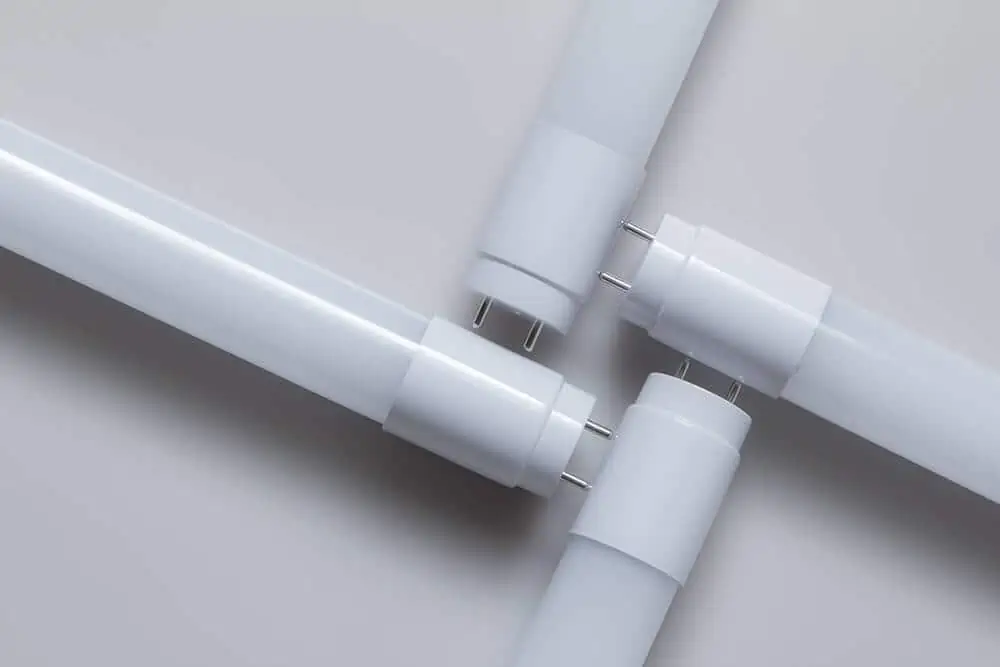
LED Tube Lights vs Fluorescent Tube Lights
LED and fluorescent tube lights look similar, but they have some key differences between them. I will provide you here an inside look contrasting the LED and fluorescent tubes–
Materials
LED tube lighting: LED tube lighting is built with a polycarbonate lens, aluminum backbone, and quality full electrical components; these enhance its functionality. Also, it is made from non-toxic, mercury- and lead-free materials. So, the LED tube is safe to use and prevents hazardous situations.
Fluorescent tube lights: Typically, fluorescent tube lights are made of plastic, glass, mercury, and metal. Since mercury is included in this tube, it can be dangerous for everyone. It can break easily and expose mercury, especially when it’s built with glass.
Installation
LED tube lighting: LED tube lights often feature a straightforward installation process. They can be directly retrofitted into existing fluorescent fixtures, with some models compatible with magnetic and electronic ballasts. This ease of installation makes them a convenient choice for retrofit projects and upgrades.
Fluorescent tube lights: The regular operation of fluorescent tubes depends on a ballast. The ballast needs to be replaced if the fluorescent tube overheats, leading to damage. When a ballast malfunctions, you need to hire an electrician to replace the faulty component and install a new ballast for the lighting system’s continued operation.
Efficiency
LED tube lighting: LED tube lights are highly energy-efficient, converting a significant portion of electricity into light rather than heat. This efficiency results in lower energy consumption and reduced electricity costs compared to traditional fluorescent tubes.
Fluorescent tube lights: Fluorescent lights are less energy-efficient than LED lights. They consume more power and contribute to higher electricity bills, making them less economical in the long run. Also, it produces about 50-100 lumens per watt (lm/w). This is because much of the energy produced is wasted because it is transformed into heat instead of light. On the other hand, LED tubes remain relatively cool. So, the whole amount of light can be made with little to no wasteful heat produced.
Color Rendering
LED tube lighting: The most significant thing you’ll notice with an LED light is its striking resemblance to natural sunlight. This is because all color spectrums are included in LED chips, resulting in remarkably bright white light. Moreover, every individual color with high CRI is replicated accurately, creating a seamless output. Appropriate lighting can enhance concentration, productivity, and overall well-being.
Fluorescent tube lights: Fluorescent illumination lacks the flattering quality found in natural lighting. This is because the color wavelengths prominently peak in blue, green, and red, resulting in a harsher color representation. Natural sunlight can seamlessly transition through colors from blue to green to red; artificial fluorescent lighting cannot replicate this smooth and natural color progression.
Longevity
LED tube lighting: LED tubes’ lifespan is longer than that of conventional fluorescent tubes. It can last up to 50,000 hours. So, it means a tube light will save cost over time as they will reduce frequent replacement and maintenance costs.
Fluorescent tube lights: This tube can last longer, from 3 to 5 years, before any replacements. However, it is based on the ballast. When the ballast is damaged, the tube will fail, too. As fluorescent tubes collapse, they will blacken often and show visible flickering, potentially leading to headaches and eyestrain. Also, it can be a particular risk to individuals with photosensitive epilepsy.
Recyclability
LED tube lighting: For recycling, you need to disassemble the LED tube first. Then, you can dispose of the plastic and aluminum at the local recycling center, and for dropping electrical components, choose an e-cycling or computer center. Also, some manufacturers accept recycled products, so contact your LED tube company.
Fluorescent tube lights: Since fluorescent tubes are made with mercury, it’s best not to drop them into the garbage. Because mercury is highly toxic and can’t be recycled as it can end up anywhere, you can contact a company that works with the disposal of fluorescent tubes correctly. It can cost like 0.80 dollars per tube.
A Quick Comparison Chart: LED Tube Lights vs Fluorescent Tube Lights
| LED Tube | Fluorescent Tube |
| LED tube lights do not have mercury. | The fluorescent tube comes with mercury. |
| The color rendering of this tube matches natural light. | Its color rendering is not similar to natural lighting. |
| This tube has a longer lifespan and can reduce costs in the long run. | Its duration is less and requires a higher maintenance cost than LED tubes. |
| LED tubes are energy efficient and consume less power. | Fluorescent tube lights consume much energy compared to LED tubes. |
| It can be recyclable and environmentally friendly. | You can’t recycle this light as it contains mercury. |
| You can control its intensity as LED tubes have dimmable features. | There is no dimmable option for this type, either on or off. |
Safety Precautions For Installing LED Tube Lights
- First, you need to ensure the power supply to the lighting fixture is turned off to avoid electrical hazards.
- Verify that the LED tube is compatible with the existing fixture to prevent malfunctions and get proper performance.
- Check the specific installation instructions the LED tube manufacturer provides for a safe and effective setup.
- Wear appropriate safety gear, such as gloves and safety glasses, to protect against potential accidents or injuries during installation.
- Examine the secure and proper wiring connections to prevent electrical issues.
- While installing, carefully inspect the LED tube for any visible damage and refrain from attaching a damaged tube to avoid safety risks.
- Work in a dry environment to prevent electrical shorts and for the safety of the installer and the electrical components.
- After it is done, test the LED tube to check its proper functioning before restoring power to the fixture.
FAQs
Depending on the manufacturer, LED tubes can range from 80 to 150 lm/W. For the exact lumens per watt, you need to check the details of a certain LED tube. And higher lumens per watt values signify more energy-efficient LED tubes.
A 20-watt LED tube light is roughly equivalent to a traditional 40-watt fluorescent tube in brightness. It provides the same level of illumination while consuming half the energy. It’s like getting the same light output with less power. Also, with LED tubes, you can get energy-efficient lights, which is a cost savings as well.
Type A LEDs are direct replacements for existing fluorescent tubes, using the same fixtures and ballasts. On the other hand, Type B LEDs bypass the ballast, requiring rewiring but enhancing energy efficiency. For example, upgrading a T8 fluorescent tube to a Type A LED involves a simple swap, while a Type B LED may require rewiring for performance.
Absolutely, replacing fluorescent tubes with LED tubes is worth it. Because LEDs offer energy savings, longer lifespans, and better light quality than fluorescent tubes. So, by using these lights, you can reduce maintenance costs. Also, they can improve efficiency and have a positive environmental impact.
No, LED tube lights are generally considered safe for the eyes. They emit minimal UV rays, reducing the risk of eye strain and damage. However, staring directly at any bright light source, including LED lights, for prolonged periods may cause discomfort.
The maximum length of an LED tube light typically depends on the specific model and manufacturer. Standard sizes range from 2 to 8 feet, but custom or industrial variations can extend beyond this range. So, it’s best to consult the product specifications provided by the manufacturer for precise details.
LED tube lights often come with waterproof features. Some LED tubes have an IP65 or higher rating, which means they can resist water and dust. However, it’s essential to check the product specifications to ensure the waterproof features.
An LED tube is highly efficient and can convert a significant portion of energy into light. For instance, a standard 20-watt LED tube can produce the same brightness as a traditional 40-watt fluorescent tube. This efficiency reduces energy consumption and leads to cost savings. Not to mention that LED tubes are a more environmentally friendly lighting solution.
Generally, an LED tube light lasts over 40,000 to 50,000 hours. Specifically, if used for 8 hours a day, it can run over 17 years. This lifespan makes LEDs more cost-effective and durable than traditional tube lights.
The voltage of an LED ranges from 1.8 to 3.3 volts, with variations based on the LED’s color. For instance, a red LED usually has a voltage drop of approximately 1.7 to 2.0 volts. On the other hand, a blue LED may exhibit a voltage drop in the range of 3 to 3.3 volts due to a higher band gap.
The Bottom Line
LED tube lights have various benefits, including energy efficiency, longer lifespan, environment friendly, etc. Also, LED tube lights are more efficient and can run for longer than traditional fluorescent tubes. However, to choose and install LED tube lights, you first need to select the type you prefer. Apart from these, you should consider factors such as their CRI, color temperature, where you want to install them, and more. Once you purchase the light, it is time to install it. For installation, gather all the materials, switch off the power for safety, and proceed with the process.
Nevertheless, tube lights are now an outdated lighting style. Instead, you can use LED strips for a modern light setting. These fixtures are easier to install than tube lights. Besides, you can also do many DIY lights using this fixture that tube lights can’t provide. So, if you want to purchase strips, contact LEDYi. We are a leading company in China and provide the best lights in over 30 countries. Also, we offer 24/7 customer service and a 3 to 5-year warranty for our strip lights. So, confirm your order soon!
